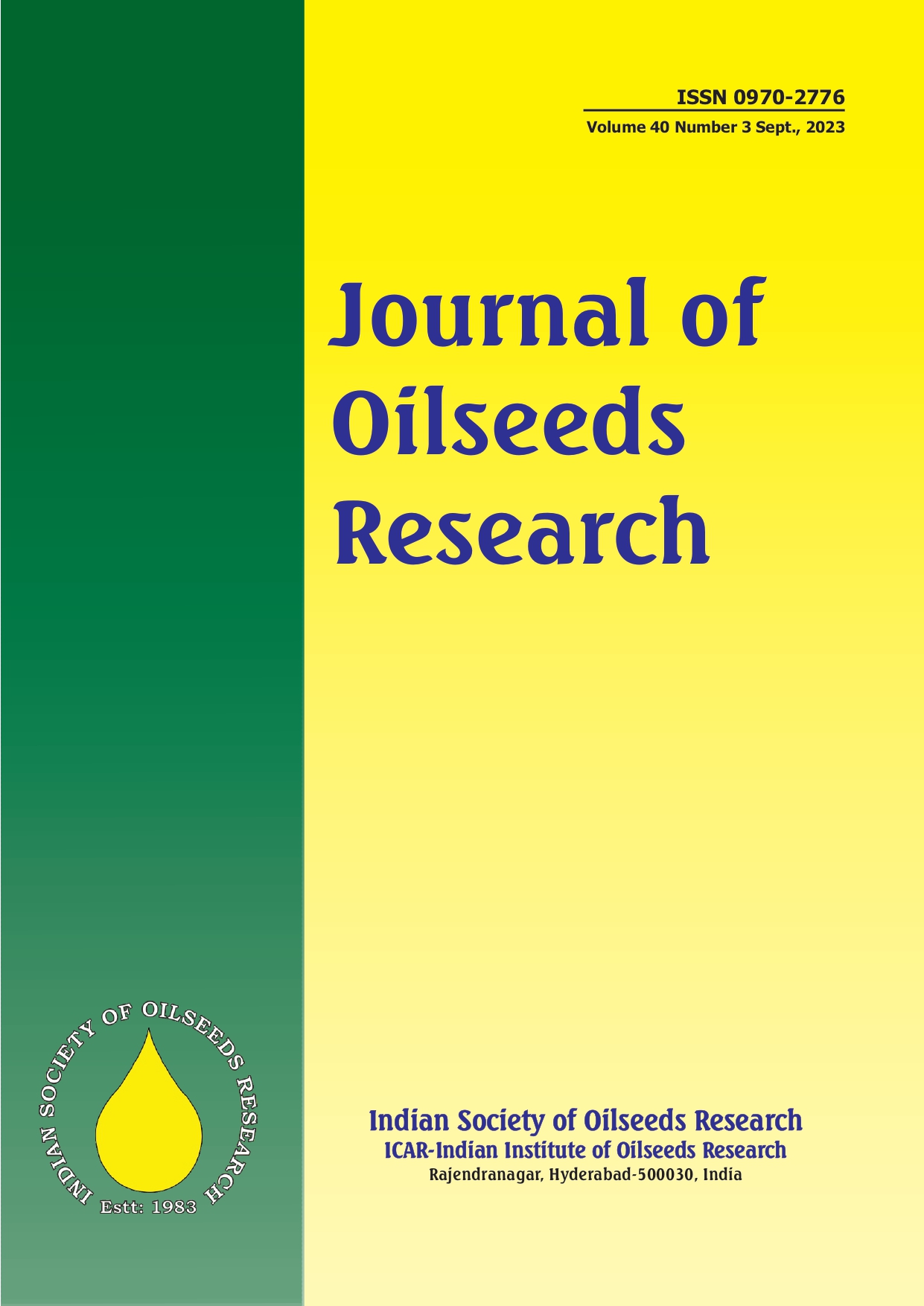Isolation and characterization of actinomycetes with in vitro antagonistic activity against Fusarium oxysporum and Meloidogyne incognita from the rhizosphere of rapeseed and mustard
ISOLATION AND CHARACTERIZATION OF ACTINOMYCETES WITH IN VITRO ANTAGONISTIC ACTIVITY
172 / 1
Keywords:
Actinomycetes isolates, Fusarium oxysporum, Meloidogyne, RhizobacteriaAbstract
Twelve isolates of actinomycetes were isolated from soilsamples collected from the rhizosphere of organically cultivated mustard and rapeseed in Sikkim, India. The isolates were morphologically distinguished for their shape and colour and microscopically characterized using Gram staining. The effective 10 Gram-positive actinomycetes isolates were examined for their bio-control efficacy against Meloidogyne incognita and Fusarium oxysporum in vitro. The isolates were studied for biochemical and molecular characterization using 16s rRNA sequencing. The effective isolate (AC-S-2) from the in vitro and biochemical studies was designated as Streptomyces hydrogenans.
Downloads
References
Cai H, Tao N and Guo C 2020. Systematic investigation of the effects of macro-elements and iron on soybean plant response to Fusarium oxysporum infection. The Plant Pathology Journal, 36(5): 398. DOI: https://doi.org/10.5423/PPJ.OA.04.2020.0069
Deepika L and Kannabiran K 2010. Biosurfactant and heavy metal resistance activity of Streptomyces spp. isolated from saltpan soil. British Journal of Pharmacology and Toxicology, 1: 33-39.
Gebreyohannes G, Moges F, Sahile Sand Raja N 2013. Isolation and characterization of potential antibiotic producing actinomycetes from water and sediments of Lake Tana, Ethiopia. Asian Pacific Journal of Tropical Biomedicine, 3(6): 426-435. DOI: https://doi.org/10.1016/S2221-1691(13)60092-1
Gomez K A and Gomez A A 1984. Statistical procedures for agricultural research, John wiley & sons. 1-657.
Gopalakrishnan S, Pande S, Sharma M, Humayun P, Kiran BK, Sandeep D, Vidya MS, Deepthi K and Rupela O 2011. Evaluation of actinomycete isolates obtained from herbal vermicompost for the biological control of Fusarium wilt of chickpea. Crop Protection, 30(8): 1070-1078. DOI: https://doi.org/10.1016/j.cropro.2011.03.006
Jalaluldeen A M, Sijam K, Othman R and Ahmad Z A M 2014. Isolation and characterization of actinomycetes with in-vitro antagonistic activity against Fusarium oxysporum from rhizosphere of chilli. International Journal of Enhanced Research in Science Technology and Engineering, 3: 45-51.
Lakshmi P S, Prasad R D and Chandrika K S V P 2022. Compatibility of Trichoderma, Bradyrhizobium sp. and Bacillus subtilis with insecticides and biopolymers. Journal of Oilseeds Research, 39(2): 117-121. DOI: https://doi.org/10.56739/jor.v39i2.141695
Lwin H T, Yin Z Z and Mya K T 2020. Isolation and antimicrobial activity of actinomycetes from chaung-tha area and biochemical characterization of selected streptomyces (TR-2). Journal of Myanmar Academy of Arts and Science, 18(4B): 145-158.
Mammadov J, Buyyarapu R, Guttikonda, S K, Parliament K, Abdurakhmonov I Y and Kumpatla S P 2018. Wild relatives of maize, rice, cotton, and soybean: treasure troves for tolerance to biotic and abiotic stresses. Frontiers in Plant Science, 9: 886. DOI: https://doi.org/10.3389/fpls.2018.00886
Mariastuti H D, Listiyowati S R I and Wahyudi A T 2018. Antifungal activity of soybean rhizosphere actinomycetes producing bioactive compounds against Fusarium oxysporum. Biodiversitas Journal of Biological Diversity, 19(6): 2127-2133. DOI: https://doi.org/10.13057/biodiv/d190619
Meena KS, Jonathan EI and Kavitha PG 2012. Viability of Pseudomonas fluorescens in liquid formulation and its effect on plant growth promotion and inhibition of root-knot nematode Meloidogyne incognita. The Madras Agricultural Journal, 99(10-12): 850-853. DOI: https://doi.org/10.29321/MAJ.10.100210
Meena KS, Jonathan EI and Devrajan K 2014. Viability studies of Pseudomonas fluorescens, Pf 1 in liquid formulation, its effect on plant growth promotion and on root knot nematode, Meloidogyne incognita. Indian Journal of Agricultural Sciences, 84(8): 993-998. DOI: https://doi.org/10.56093/ijas.v84i8.43137
Nimnoi P and Ruanpanun P 2020. Suppression of root-knot nematode and plant growth promotion of chilli (Capsicum flutescens L.) using co-inoculation of Streptomyces spp. Biological Control, 145: 104244. DOI: https://doi.org/10.1016/j.biocontrol.2020.104244
Pandey B, Ghimire P and Agrawal VP2004. Studies on the antibacterial activity of actinomycetes isolated from Khumbu region of Mount Everest. Journal of Applied Mirobiology, 20: 45-54.
Passianotto A L D L, Sonah H, Dias W P, Marcelino-Guimaraes F C, Belzile F and Abdelnoor RV 2017. Genome-wide association study for resistance to the southern root-knot nematode (Meloidogyne incognita) in soybean. Molecular Breeding, 37: 1-11. DOI: https://doi.org/10.1007/s11032-017-0744-3
Preeti V, Sharan H S and Rathi A S 2022. Biological control of charcoal rot of sesame caused by Macrophomina phaseolina. Journal of Oilseeds Research, 39(2): 146-148. DOI: https://doi.org/10.56739/jor.v39i2.141710
Ramyabharathi SA, Meena KS, Rajendran L, Karthikeyan G, Jonathan E I and Raguchander T 2018. Biocontrol of wilt-nematode complex infecting gerbera by Bacillus subtilis under protected cultivation. Egyptian Journal of Biological Pest Control, 28:1-9. DOI: https://doi.org/10.1186/s41938-018-0027-2
Rashad F M, Fathy H M, El-Zayat A S and Elghonaimy A M 2015. Isolation and characterization of multifunctional Streptomyces species with antimicrobial, nematicidal and phytohormone activities from marine environments in Egypt. Microbiological Research, 175: 34-47. DOI: https://doi.org/10.1016/j.micres.2015.03.002
Remya M and Vijayakumar R 2008. Isolation and characterization of marine antagonistic actinomycetes from west coast of India. Medicine and Biology, 15(1): 13-19.
Ruanpanun P andChamswarngC 2016. Potential of actinomycetes isolated from earthworm castings in controlling root-knot nematode Meloidogyne incognita. Journal of General Plant Pathology, 82: 43-50. DOI: https://doi.org/10.1007/s10327-015-0637-4
Salim F M, Sharmili S A, Anbumalarmathi J and Umamaheswari K 2017. Isolation, molecular characterization and identification of antibiotic producing actinomycetes from soil samples. Journal of Applied Pharmaceutical Science, 7(9): 69-75.
Sapkota A, Thapa A, Budhathoki A, Sainju M, Shrestha P and Aryal S. 2020. Isolation, characterization, and screening of antimicrobial-producing actinomycetes from soil samples. International Journal of Microbiology, 1-7. DOI: https://doi.org/10.1155/2020/2716584
Sherpa M T, Mathur A and Das S 2015. Medicinal plants and traditional medicine system of Sikkim: a review. World Journal of Pharmacy and Pharmaceutical Sciences, 4(2): 161-184.
Vishwanatha B T, Babu G, Malagi S B, Dandin C J and Nayaka S 2017. Isolation, identification and characterization of streptomyces sp. SN-2. Biosciences Biotechnology Research Asia, 14(4): 1401-1407. DOI: https://doi.org/10.13005/bbra/2585
Williams S T and Cross T 1971. Actinomycetes. In. Methods in Microbiology. (Booth, C. Ed.). Academic press, London. pp. 29-65.
Xue L, Xue Q, Chen Q, Lin C, Shen G and Zhao J 2013. Isolation and evaluation of rhizosphere actinomycetes with potential application for biocontrol of Verticillium wilt of cotton. Crop Protection, 43: 231-240. DOI: https://doi.org/10.1016/j.cropro.2012.10.002
